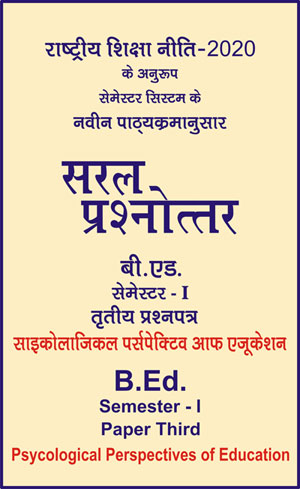|
बी एड - एम एड >> बी.एड. सेमेस्टर-1 प्रश्नपत्र-III - साइकोलाजिकल पर्सपेक्टिव आफ एजूकेशन बी.एड. सेमेस्टर-1 प्रश्नपत्र-III - साइकोलाजिकल पर्सपेक्टिव आफ एजूकेशनसरल प्रश्नोत्तर समूह
|
5 पाठक हैं |
|||||||
बी.एड. सेमेस्टर-1 प्रश्नपत्र-III - साइकोलाजिकल पर्सपेक्टिव आफ एजूकेशन (अंग्रेजी भाषा में)
Question- Describe the Gestalt insight theory
Answer-
Gestalt Insight Theory
This theory was propounded by German psychologist Vardimer, Koffka and Kohler. “A Gestalt’s figure is a composite whose characteristics are ascertained. It is also called the principle of insight.”
Learning According to Gestalt Litigants : It was only after Gestalt psychologists started an intellectual movement that post Gestalt development took place. Gestalt theory develops as a reaction to associative theory. When a person learns, he keeps the whole situation in his sight, only then he can find a solution to the problem.
Meaning of Theory : Kohler a German resident was sent to an institution for anthropological studies in 1913. Where he studied orangoutang extensively in the deserted place at the start of the First World War. We learn something by doing certain things, by watching the task and some by not doing the task but by telling the name of them. This type of learning is called the principle of understanding.
According to Kohlar : “Research in more than one technical sense refers to the rapid capture of a solution to a problem by starting a process that adopts to the situation and brings about a solution to the problem in terms of the field number of perceptual knowledge. He says that the actual structure should be up and open for inspection to the solution.”
Experiment of Kohlar : The Gestalt plaintiffs of Germany are the exponents of the theory of learning by understanding. The Gestaltists and Kohler did many experiments, the most famous of them are as under :
(A) Box Problem Experiment : Kohlar did many experiments on orangutang. Kohlar locked six orangutang in a room. A banana was hub in the ceiling of the room and a box was kept at a distance. The orangutans jumped up and tried to pick up the banana but did not succeed. The wisest of them all was one orangutan, who was named Sultan by Kohlar. He wandered around the room for a while and he looked at the box. Suddenly he pulled the box and put the hanging banana down and climbing on the box and he managed to get the banana.
(B) Stick Problem Experiment : Kohlar locked the Sultan in the courtroom and placed a pointed stick inside the courtroom. The bananas kept outside the house, were kept so far from the box that they could not be found without stretched hands. Orangoutang first extended his hand to lift the banana but could not get it alone. After a while the orangutan saw the stick and the idea came in his mind to pull the banana with the help of the stick and he did the same then he got success in getting it alone.
After this two sticks were kept in the courtroom. The two sticks were such that they could be lengthened by fitting into each other. The hungry orangutang, who kept bananas at a distance outside the box, thought that by extending his hand, the benefit should be taken, but he was not successful in the task. Then he tried to get the banana through a stick but could not get it either. He started playing with both the sticks. Suddenly both stick joined together and became a long stick with the help of it, he was able to pull the bananas.
Conclusions of Experiments : From the experiment of Kohlar – The action of doing a task takes place at two levels of the brain :
• Learning at the direct cognitive level.
• Learning at the conceptual level.
At the perceptual cognitive level when the creature reacts to the direct knowledge of the whole situation with the help of the senses, only then he becomes successful. Man is supposed to be considerate and prudent. In th.s way the problem reflects the complete situation and solves the problem immediately. It is clear from above information that the learning process in the Kohlar box experiment is at a direct cognitive level.
Factors : Following are the factors based on the appropriate conclusion:
(1) Intelligence : Those with fast intelligence have more insight ability and less intellect has less insight ability.
(2) Perception of the Overall Situation and Problem : After studying all the things, the knowledge of the whole situation is attained.
(3) Trial and Error : By doing trails and errors learning insight suddenly arises.
(4) Experience : There are many sequence of experiences in learning. These experiences coalesce into a Gestalt form, as the orangutang first climbs on box to get the banana. But when he did not get succeed he placed a second box on top of the previous one and tried to climb on it and took it down and succeeded.
In the same way, man makes rules on the basis of all.
|
|||||














